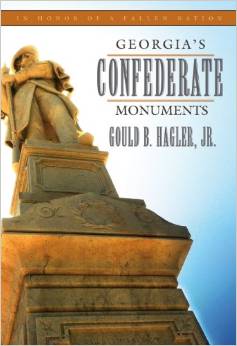Georgia’s Confederate Monuments: In Honor of a Fallen Nation by Gould B. Hagler, Jr. Mercer University Press, 2014. Cloth, ISBN: 978-0-88146-466-5. $45.00.
 The expanding field of Civil War memory has opened a vibrant dialogue on questions of race and reunion, the monolithic nature of reconciliation, the process of preserving and interpreting the War’s battlefields, and the conflicting and complicated means in which Americans understand our nation’s Civil War. In the years following Appomattox, northerners and southerners alike crafted their respective narratives of the Civil War. Through a flurry of veterans’ associations, journals, and parades, men and women perpetuated their remembrances of the Civil War and the cause for which they fought. Throughout the nation, in dozens of cities and towns, and on scores of “hallowed ground,” Civil War monuments—the stone sentinels—became tangible indicators of the Civil War’s commemorative tradition.
The expanding field of Civil War memory has opened a vibrant dialogue on questions of race and reunion, the monolithic nature of reconciliation, the process of preserving and interpreting the War’s battlefields, and the conflicting and complicated means in which Americans understand our nation’s Civil War. In the years following Appomattox, northerners and southerners alike crafted their respective narratives of the Civil War. Through a flurry of veterans’ associations, journals, and parades, men and women perpetuated their remembrances of the Civil War and the cause for which they fought. Throughout the nation, in dozens of cities and towns, and on scores of “hallowed ground,” Civil War monuments—the stone sentinels—became tangible indicators of the Civil War’s commemorative tradition.
In Georgia’s Confederate Monuments, Gould Hagler, Jr., offers an encyclopedic volume covering approximately 140 monuments erected to honor Georgia’s Confederate men and women. Organized alphabetically, Hagler’s work presents a litany of facts about each monument, including contemporary black and white photographs, its location, date of dedication, the style, materials used, and the name of the builder. Hagler also includes a diligent reproduction of each monument’s inscription. In some instances, he provides an explanatory text on the erection or the history of the monument, including the cost of the monument or instances where the monument was relocated.
In his introduction, Hagler attempts to situate these monuments within the broader trends of Civil War commemoration. He notes that the early monuments resulted from the commemorative activities of various ladies’ organizations, with the flurry of monument production occurring in the final years of the nineteenth century. Though not explicitly apparent in the organization of his book, Hagler briefly identifies the evolutionary nature of Georgia’s Civil War commemorative activity, namely the transition from monument designs evoking a mourning sentiment to a celebratory nature of the Confederate warrior. The placement of the monuments changed over time, too. Reflective of a mourning tradition, monuments erected in the immediate postwar years were often placed in cemeteries, among Confederate graves. Comparatively, monuments erected near the turn of the century were placed in public spaces, often on courthouse grounds. These monuments stood as a more celebratory, or “martial” symbols (xii).
While compiling an encyclopedic volume of Georgia’s Confederate monuments, Hagler’s work falls short in offering substantive analysis on Georgia’s Civil War commemorative traditions. The product of over two decades of work, assembling such a factual and photographic volume of 140 monuments throughout the state is, in itself, a commendable task. Individuals interested in knowing of the location, dedication date, fabricator, or builder of Georgia’s Confederate monuments will be well served by Hagler’s work. Yet Hagler misses an opportunity for insightful, scholarly narrative that utilizes the dedication of these monuments to explore broader themes of Civil War commemorative activity. Though the monument inscriptions offer some insight into “how the builders viewed their history,” examination of the speeches accompanying the dedication of these monuments would offer an indication to how the men and women of Georgia’s Confederacy coped with death, reconciled with defeat, and envisioned their sacrifice in a post Civil War South (314). To what extent did Georgians erect these monuments as testimony to the “Lost Cause” or the “Unreconstructed Rebel”? How has the nature of Georgia’s commemorative tradition changed over time? Overall, Georgia’s Confederate Monuments gives less insight into the nature of the state’s commemorative tradition and its place within Civil War memory, but aptly serves as an excellent reference work for the factual information for Georgia’s Confederate monuments.
Jennifer M. Murray is Assistant Professor of History at The University of Virginia’s College at Wise and the author of On a Great Battlefield: The Making, Management, and Memory of Gettysburg National Military Park, 1933.
